| |
|
Xiamen Oil Paintings, Wholesale Direct!
|
|
100% hand painted, 100% cotton canvas, 100% money back if not satisfaction. |
|
|
|
|
ART WORKS INDEX
A
B
C
D
E
F
G
H
I
J
K
L
M
N
O
P
Q
R
S
T
U
V
W
X
Y
Z
|
|
ARTISTS INDEX
A
B
C
D
E
F
G
H
I
J
K
L
M
N
O
P
Q
R
S
T
U
V
W
X
Y
Z
|
|
|
|
|
|
|
|
|
|
|
|
 |
Machuca, Pedro
|
|
Spanish, approx. 1490-1550
Spanish painter and architect. The form of his signature (Petrus Machuca, Hispanus. Toletanus ...) on his earliest known work, the Virgin of Succour (1517; Madrid, Prado), suggests he was active at an early age in Italy. On the basis of the style of that work, a number of frescoes in the Vatican have been attributed to him, including Isaiah Blessing Jacob. Other works from the same period that have been attributed to him include a copy (Paris, Louvre) of the destroyed Battle of Anghiari by Leonardo da Vinci and two paintings of the Virgin and Child
|
|
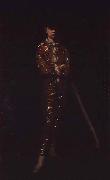 |
Mabel Pryde
|
|
(February 12,1871, Edinburgh - July 1918, England.) was an artist, best known for being the wife of artist William Nicholson and mother of artists Ben Nicholson and Nancy Nicholson and the architect Christopher 'Kit' Nicholson.
Mabel was the daughter of David Pryde, Headmaster of Edinburgh Ladies College 1870-1891, and Barbara Lauder, whose father William was a brother of the famous Scottish artists Robert Scott Lauder and James Eckford Lauder. Mabel had one brother, the artist James Pryde. As children they lived at 10 Fettes Row, a north-facing Edinburgh house.
Pryde trained at the Bushey School of Art under the tutilage of Hubert von Herkomer. Here she met fellow student William Nicholson whom she married in 1893. She introduced Nicholson to her brother James and all three moved to Eight Bells, Denham, Buckinghamshire, where Nicholson and James Pryde would collaborate on the famous series of lithographic posters they disseminated under the pseudonym J. & W. Beggerstaff.
Pryde and Nicholson had four children - Ben (1894-1982); Anthony (1897-1918) who was killed in action during the First World War; Annie Mary "Nancy" (1899-1978), and Christopher "Kit" (1904-1948). In July 1918 Pryde died from influenza in during the 1918 flu pandemic and was survived by her husband.
|
|
|
|
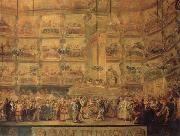 |
Luis Paret y alcazar
|
|
Spanish Rococo Era Painter, 1746-1799
was a Spanish painter of the late-Baroque or Rococo period. He was born in Madrid he first trained with Antonio Gonz??lez Velazquez and attended the Academia Real de San Fernando in Madrid, where he won a second prize in a painting contest in 1760, and first prize in 1766. He entered the studio of the French painter Charles de la Traverse, who worked for the Marchese of Ossun, the ambassador of France in Spain. Unfortunately upon returning to Madrid, despite becoming a teacher in the Academia de San Fernando at age 33 years, he mainly received royal commissions to paint and engrave vistas of ports, the Spanish equivalent of vedute, and also of planned works of construction. For some years, he was banished to Puerto Rico, where he trained the painter Jose Campeche.
|
|
 |
Luigi Premazzi
|
|
(Milan, 1814 - Istanbul, Turkey, 1891) was an Italian painter.
Premazzi attended the Brera Academy of Fine Arts and then the private school run by Giovanni Migliara. His early watercolours, based on the works of his master, were produced for the lithographic industry. His oeuvre is characterised by a repertoire of urban views produced in accordance with the dictates of perspective painting. While most of these are set in Milan, other Italian cities were also featured in later years. His smooth, precise painting also shows the influence of his contemporary Luigi Bisi in its descriptive focus on architectural detail. He presented work regularly at the exhibitions of the Societe Promotrice di Belle Arti in Turin from 1842 to 1848 as well as those of the Brera Academy. Having moved to Saint Petersburg around 1850, he became a teacher at the Imperial School of Fine Arts there in 1861. Frequent stays in the Caucasus and the Middle East provided new subjects for his paintings, which he continued to send to Italian exhibitions, where they aroused wonder and curiosity.
|
|
|
|
 |
Ludovic Piette
|
|
French Painter, 1826-1878.French painter. He studied at the Ecole des Beaux-Arts in Paris during the 1850s under Isidore Pils and Thomas Couture. He attended classes at the Acad?mie Suisse and made his Salon d?but in 1857 with The Scorpion Broom (ex-Mus. B.-A., Rouen). His early works were often based on literary sources and include The Phantoms (exh. Salon 1859) and The Witches Appearing to Macbeth (exh. Salon 1861). Piette only exhibited at the Salon on two further occasions (1872 and 1876), preferring instead to sell his work at auction in the H?tel Drouot. In the early 1860s he abandoned literary subjects in favour of working directly from nature, a shift that probably relates to his developing friendship with Camille Pissarro. This association is first documented by Pissarros portrait of Piette in his Studio (1861; Dr and Mrs Jordan H. Trafimow priv. col.) and an important correspondence between the two artists from 1863 to 1877 survives. Piette portrayed Pissarro painting out of doors (c. 1870; priv. col., see Pissarro, exh. cat., ACGB, 1980, no. 322).
|
|
 |
Lucien Pissarro
|
|
French Camden Town Group Painter, 1863-1944
was a French painter, printmaker and wood engraver. Eldest son of the Impressionist painter Camille Pissarro, he was born in Paris and studied with his father. His works employ techniques of Impressionism and its successor, Neo-impressionism, but he also exhibited with Les XX. From 1890 he lived in London, becoming a British citizen in 1916. While in England he was one of the founders of the Camden Town Group of artists. In 1919, he formed the Monarro Group with J.B. Manson as the London Secretary and Theo van Rysselberghe as the Paris secretary, aiming to show artists inspired by Impressionist painters, Claude Monet and Camille Pissarro.
|
|
|
|
|
|
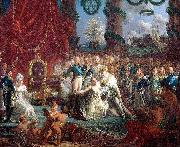 |
Louis-Philippe Crepin
|
|
(1772-1851) was a French naval painter, one of the first Peintres de la Marine.
Crepin was notably a pupil of Joseph Vernet and Hubert Robert.
His Combat de la Bayonnaise contre l'Ambuscade, 1798, depicting the Action of 14 December 1798, is one of the main exhibits of the Musee national de la Marine.
|
|
|
|
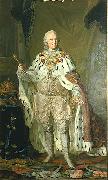 |
Lorens Pasch the Younger
|
|
(1733-1805) was a Swedish painter
He grew up in an artistic family (he was the brother of Ulrika Pasch, alongside whom he was elected to the Art Academy in 1773), but his father Lorens Pasch the Elder wanted him to become a priest. He was thus sent to study in Uppsala aged 10. However, he decided on an artistic career after all and began an apprenticeship in his father's studio before going to Copenhagen, with introductions from his wealthy and influential uncle Johan Pasch. There he studied painting for three years in the studio of Carl Gustaf Pilo. Despite good offers of studio-apprenticeships and commissions from Sweden, he then set off for Paris in 1758 to complete his artistic education. There he specialised in history painting in the studios of Eustache Le Sueur and François Boucher (though for financial reasons he also continued his training in portraiture) and became friends with fellow-Swede Alexander Roslin.
In 1764 he left Paris and got back to Sweden in 1766. He fully completed his training in the studio of the French painter Guillaume Taraval, who in 1735 founded the Royal Swedish Academy of Arts in Stockholm. Soon after his arrival back in Sweden Pasch's gained a great reputation as a portraitist, gaining favour and commissions from the royal court and gaining the esteem of Adolf Frederick, King of Sweden and his queen Louisa Ulrika - one of his most notable works is his Portrait of Louisa Ulrika of Prussia. He served as a professor at the Academy of Arts from 1773 to his death, becoming its director on Pilo's death in 1793. At the end of his life he concentrated more on training young artists and managing the Academy than on painting. He died unmarried in 1805 and due to his powerful portraits remains one of the most respected painters of the Gustavian era in Sweden.
|
|
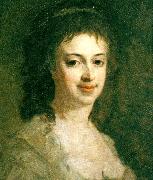 |
lorens pasch d.y
|
|
Lorens Pasch d.y., född 1733, död 1805, konstnär; professor vid Konstakademien från 1773. Son till Lorens Pasch d.ä., bror till Ulrika Pasch, brorsson till Johan Pasch. Invald tillsammans med sin syster i Konstakademien 1773.
|
|
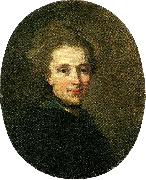 |
lorens pasch d. y
|
|
Lorens Pasch d.y., född 1733, död 1805, konstnär; professor vid Konstakademien från 1773. Son till Lorens Pasch d.ä., bror till Ulrika Pasch, brorsson till Johan Pasch. Invald tillsammans med sin syster i Konstakademien 1773.
|
|
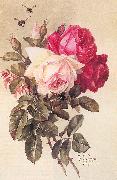 |
Longpre, Paul De
|
|
French, practiced mainly in America, 1855-1911
was a French flower painter, actively chiefly in the United States. He was born in Lyons, France, and was entirely self-taught. From his twelfth year he practiced successfully in Paris as a painter of fans. At 21 he first exhibited at the Salon. Having lost his money by the failure of a Paris bank, he moved in 1890 to New York and in 1896 held an exhibition of flower pieces which secured him instant recognition. In 1899 he moved to California and two years later built a beautiful house at Hollywood, which became celebrated for its magnificent flower gardens. De Longpre painted only perfect specimens of flowers; with delicacy of touch and feeling for bosoms he united scientific knowledge, and he also knew how to give expression to the subtle essence of the flowers.
|
|
 |
LONGHI, Pietro
|
|
Italian Rococo Era Painter, ca.1702-1785
Painter and draughtsman. His father, Alessandro Falca, encouraged his natural talent for drawing, and he studied under Antonio Balestra for 'several years', according to his son, Alessandro Longhi. Balestra probably took Pietro to Bologna and recommended him to Giuseppe Maria Crespi. No documents exist on Longhi until 1732, the year he married, and some doubt has been expressed about his study with Crespi. There is no trace of Crespi's influence in Longhi's altarpiece for the parish church of S Pellegrino in Bologna, St Pellegrino Condemned to Death, installed in 1732; Crespi's style is an intimate one, however, and would have been inappropriate for such a large altarpiece. One of Longhi's first independent works, the St Pellegrino altarpiece recalls his Venetian origins and training in its broken brushwork and colour glazes. In another early work, the Adoration of the Magi (Venice, Scuola Grande S Giovanni Evangelista), documented in 1733 as at S Maria Materdomini, Venice, the subject-matter lends itself to a more domestic treatment, and Crespi's influence is evident. Both these works contain passages anticipating Longhi's subsequent development as a genre painter; in each picture a boy or young man, perhaps a self-portrait, gazes out at the spectator, unconcerned with events in the painting.
|
|
 |
Ljubov Popova
|
|
Russian Constructivist Painter and Designer, 1889-1924
Through a synthesis of styles Popova worked towards what she termed painterly architectonics. Exploring firstly Impressionism, by 1913, in Composition with Figures, she was experimenting with the particularly Russian development of Cubo-Futurism: a fusion of two equal influences from France and Italy.
Portrait of a Philosopher (Artists's brother, Pavel Sergeyevich Popov), 1915From 1914-1915 her Moscow home became the meeting-place for artists and writers. In 1914-1916 Popova together with other avant-garde artists (Aleksandra Ekster, Nadezhda Udaltsova, Olga Rozanova) contributed to the two Jack of Diamonds exhibitions, then in Petrograd Tramway V and the 0.10, The Store in Moscow.
In 1916 she joined the Supremus group with Kazimir Malevich, the founder of Suprematism, Aleksandra Ekster, Ivan Kliun, Nadezhda Udaltsova, Olga Rozanova, Ivan Puni, Nina Genke, Ksenia Boguslavskaya and others who at this time worked in Verbovka Village Folk Centre. However there was a tension between those who like Malevich saw art as a spiritual quest and others who responded to the need for the artist to create a new physical world. Popova embraced both of these ideals but eventually identified herself entirely with the early aims of the Revolution working in poster, book design, fabric and theatre design, as well as teaching.
Her painting The Violin of 1914 reveals the development from cubism towards the "painterly architectonics" of 1917- 1918. Before joining the Supremus group her paintings, the architectonic series defined her artistic trajectory, quite distinct from that of Malevich, Rozanova, Tatlin and Mondrian, in abstract form. The canvas surface is an energy field of overlapping and intersecting angular planes in a constant state of potential release. At the same time the elements are held in a balanced and proportioned whole as if linking the compositions of the classical past to the future. By 1918 colour is used as the iconic focus; the strong primary colour at the centre drawing the outer shapes together.
In 1918 Popova married von Eding, and gave birth to a son, but von Eding died the following year of typhoid fever. She worked on Agitprop designs, and in 1919 she contributed to Tenth State Exhibition: Non Objective Creativity and Suprematism. She painted more advanced abstract works in 1919-21. In 1921 she exhibited in the 5 x 5 Exhibition.
From 1921-24 Popova became active in Constructivist projects, sometimes in collaboration with the architect Alexander Vesnin. She was active in stage designs: Vsevolod Meyerhold's production of Fernand Crommeldynck's The Magnanamous Cuckold, 1922; and in teaching: Spatial Force Constructions were used as the basis of an art teaching theory. She designed typography of books, production art and textiles, and contributed designs for dresses to LEF.
Popova died in Moscow. A large exhibition of her work opened in Moscow on 21 December 1924.
|
|
|
|
 |
Lilla Cabot Perry
|
|
American Impressionist Painter, 1848-1933
was an American artist who worked in the Impressionist style, rendering portraits and landscapes in the free form manner of her mentor, Claude Monet. Perry was an early advocate of the French Impressionist style and contributed to its reception in the United States. Perry's early work was shaped by her exposure to the Boston school of artists and her travels in Europe and Japan. She was also greatly influenced by Ralph Waldo Emerson's philosophies and her friendship with Camille Pissarro. Although it was not until the age of thirty-six that Perry received formal training, her work with artists of the Impressionist, Realist, Symbolist, and German Social Realist movements greatly affected the style of her oeuvre. Boston native Lilla Cabot Perry was born on January 13, 1848 to Dr. Samuel Cabot, a distinguished surgeon, and Hannah Lowell Jackson Cabot. What is known of her early life reveals a childhood that allowed her the freedom of exploring her interests and creativity. Perry studied literature, language, poetry, and music. There are a few references to Perry having informal sketching sessions with her friends however she had no formal training in the arts before 1884. As a child she additionally enjoyed reading books and playing sports outdoors. Because of her family's prominence in Boston society,
|
|
|
|
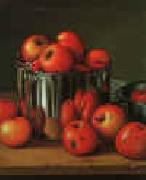 |
Levi Wells Prentice
|
|
1850-1935
Levi Wells Prentice Gallery
Prentice was associated with the Hudson River School, a group of artists known throughout art circles. According to the book Nature Staged by Barbara Jones, Prentice followed a self-prescribed educational path, begun by the Hudson River School and reinforced by John Ruskin's (1819-1900) truth-to-nature principles laid out in his book Modern Painters. Although he can be allied to both schools of thought, Prentice can not be considered a member of either. This book has a photo of the artist in his early Brooklyn studio surrounded by his paintings and a complete essay on his life and work.
Levi grew up on a farm in Lewis County, New York. By 1872, Prentice had traveled through the Adirondack Mountains, painting the views as well as the surrounding region. He opened his first studio as a landscape painter in Syracuse, New York in 1875.
Self-taught artist Levi Wells Prentice is best known for his realistic still life compositions of fruit arranged within a landscape, or abundantly spilling from bushel baskets. Early in his career, he painted portraits and landscapes of the Adirondack Mountain region of Lewis County, New York, his birthplace.
Levi married an English woman Emma Roseloe Sparks in Buffalo, New York in 1882 and had two children, Leigh (born 22 March 1887) and Imogene (born 17 September 1889).
Prentice then turned to painting still life subjects when he moved briefly to Brooklyn, New York in 1883, focusing on fruit, in order of frequency apples, strawberries, peaches, plums, raspberries, cherries, muskmelons, pears, currants, pineapples, gooseberries, grapes and bananas usually piled high in pots or in natural settings.
Prentice subsequently moved around from 1903-07 before settling in the Germantown district of Philadelphia. However, his work did not gain much recognition with historians until the 1970s. He was a member of the Brooklyn Art Association and frequently exhibited his paintings there.
In addition to his artistic talents, he was a craftsman who enjoyed making his own brushes, palettes and frames.
In his painting, Prentice placed an emphasis on dark outlining with a concern for textual precision, creating dramatic contrasts. The shift between dark background areas and the vibrant hues of the fruit are done to give the compositions an exciting, visual energy. The fruit is presented with clarity and precision. An emphasis appears to be placed on the idea of man versus nature. The wooden baskets with hand-wrought nails represent a structured, man-made object, while the overly ripe fruit represents the fleeting qualities of nature. These paintings also demonstrate Prentice's remarkable skills at rendering color, form, and texture.
Noted art historian William H. Gerdts observed: there are several works by Prentice in which he achieves a quality of illusionism which is unsurpassed. In 1993, the skillful 'illusionism' of Levi Wells Prentice was celebrated in a retrospective exhibition at the Adirondack Museum in New York. His works continue to receive a high degree of appreciation by collectors today. He is represented in many museums including the New York State Museum, Museum of Fine Arts, Boston, Montclair Art Museum, Philbrook Museum of Art and Yale University Art Gallery.
Levi died 28 November 1935 in Germantown, Pennsylvania.
|
|
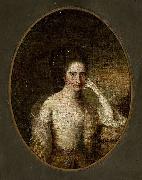 |
Leonor de Almeida Portugal
|
|
Leonor de Almeida Portugal de Lorena e Lencastre (Lisboa, 31 de outubro de 1750 - Benfica, 11 de outubro de 1839) foi uma nobre e poetisa portuguesa.
|
|
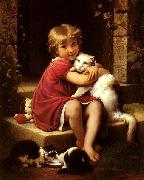 |
Leon Bazille Perrault
|
|
(20 June 1832, Poitiers - 1908, Royan) was a French painter.
A student of William Bouguereau and François-Edouard Picot, he exhibited at the Salon from 1863 onwards, producing several works, in the academic tradition. He was famous for his le petit naufrag (The little shipwrecked boy, 1874) and his paintings of children.
|
|
|
|
 |
Leo Putz
|
|
Germany (1869 -1940 ) - Painter
|
|
|
|
 |
Laszlo Paal
|
|
Laszlo Paal (1846-1879) was a Hungarian Realist landscape painter. He was a pupil of Mihaly Munkacsy. His pictures are representative of lyrical realism: his oeuvre is related to the tendencies of the Barbizon School.
|
|
 |
LASTMAN, Pieter Pietersz.
|
|
Dutch Baroque Era Painter, ca.1583-1633
Dutch painter and draughtsman. He was the son of the goldsmith Pieter Segersz. His older brother Seeger Pietersz. [Coninck] became a goldsmith like his father, while his younger brother Claes Lastman became an engraver and painter. Pieter trained as a painter under the Mannerist artist Gerrit Pietersz., brother of the composer Jan Pietersz. Sweelinck. In June 1602 Lastman travelled to Rome, like so many of his contemporaries. Van Mander, in his biography of Gerrit Pietersz., mentioned his pupil 'Pieter Lasman [sic] who shows great promise, being presently in Italy'. While there, Lastman made two drawings of an Oriental in a Landscape (both 1603; Amsterdam, Rijksmus.), which betray his continuing stylistic dependence on his master (as can also be seen in three drawings made before his trip to Italy). Related to the drawings made in Italy is a series of 12 prints after designs by Lastman of figures in Italian costumes (Hollstein, nos 11-22). Lastman also visited Venice, as is documented by a drawing (Cambridge, Fitzwilliam) after Veronese's Adoration of the Shepherds in the church of SS Giovanni e Paolo. Lastman was apparently in Italy until March 1607 but thereafter spent the rest of his life in Amsterdam.
|
|
|
|
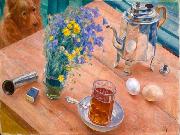 |
Kuzma Sergeevich Petrov-Vodkin
|
|
(1878, Khvalynsk, now Saratov OblasteFebruary 15, 1939, Leningrad) was an important Russian and Soviet painter and writer.
Kuzma Petrov-Vodkin was born in Khvalynsk (Saratov Oblast) into the family of a local shoemaker. His first exposure to art was in his early childhood, when he took some lessons from a couple of icon painters and a signmaker. Still, Petrov-Vodkin didn't quite see himself in art at that time; after graduating from middle school, he took a summer job at a small shipyard with plans to get into railroad college in Samara. After failing his exam, he turned to "Art Classes of Fedor Burov" in 1893.
In April 1895, Burov died and for some time Petrov-Vodkin took different painting jobs in the vicinity of Saratov. By chance, his mother's employer invited a well-known architect, R. Meltzer. Petrov-Vodkin was introduced to the guest and impressed him enough to get an invitation to study art at Saint Petersburg. The education was financed by a charitable subscription among local merchants. He also met at this time Borisov-Musatov, an important painter resident in Saratov, who encouraged Petrov-Vodkin to continue his studies.
Petrov-Vodkin stayed in Saint Petersburg from 1895 to 1897 studying at the Baron Stieglits School, before moving to the Moscow School of Painting, Sculpture and Architecture. There Petrov-Vodkin was a student of Valentin Serov, Isaak Levitan and especially Konstantin Korovin. In 1901 he travelled to Munich to take classes with Anton Ažbe.
He graduated in 1904.
|
|
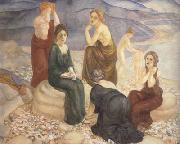 |
Kuzma Petrov-Vodkin
|
|
Russian Painter, 1878-1939
Russian painter. He began his studies in the drawing and painting classes of F. Burov (1843-95) in Samara (1893-5), and he attended Baron Stieglitz's school in St Petersburg from 1895 to 1897. He studied under Abram Arkhipov, Nikolay Kasatkin and Valentin Serov at the Moscow School of Painting, Sculpture and Architecture from 1897 to 1905 and at Anton Azb?'s school in Munich (1901). After working in various private studios in Paris between 1905 and 1908, he travelled to Constantinople (now Istanbul), Greece and Italy in 1905 and to Algiers in 1906. On his return to Russia, he held an exhibition in the editorial offices of the magazine Apollon in St Petersburg (1909). From 1911 to 1924 he exhibited with the WORLD OF ART group and from 1925 to 1928 with the FOUR ARTS SOCIETY OF ARTISTS. From the early 1910s Petrov-Vodkin's work was influential in the artistic life of St Petersburg. He attempted to reconcile classical and modern trends. His style was formed under a wide range of influences, often seemingly incompatible: 19th-century Russian painters such as Aleksey Venetsianov,
|
|
|
|
 |
KONINCK, Philips
|
|
Dutch Baroque Era Painter, 1619-1688
was a Dutch landscape painter.Little is known of his history except that he was said to be a pupil of Rembrandt, whose influence is to be seen in much of his work. He painted chiefly broad, sunny landscapes, full of space, light and atmosphere; they are seen from a high perspective, allowing a prominent view of the sky. Portraits by him, somewhat in the manner of Rembrandt, also exist (e.g. see Joost van den Vondel); there are examples of these in the galleries at Copenhagen and Oslo. Of his landscapes, the principal are View at the mouth of a river at the Hague, with a slightly larger replica in the National Gallery, London; Woodland border and countryside (with figures by Adriaen van de Velde) at Amsterdam; and landscapes in Brussels, Florence (the Uffizi), Berlin and Cologne. Koninck, a prosperous businessman, appears to have painted few pictures during the last decade of his life. Several of his works have been falsely attributed to Rembrandt and many more to his namesake and fellow townsman Salomon de Koninck (1609-1656), also a disciple of Rembrandt, whose paintings and etchings consist mainly of portraits and biblical scenes. Both of these painters are to be distinguished from David Koninck (1636-1687),
|
|
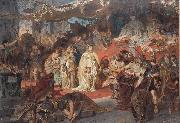 |
Karl von Piloty
|
|
Karl Theodor von Piloty (1 October 1826 - 21 July 1886) was a German painter.
Von Piloty was born in Munich. His father, Ferdinand Piloty (d. 1844), enjoyed a great reputation as a lithographer. In 1840, Karl was admitted as a student of the Munich Academy, under the artists Karl Schorn and Julius Schnorr von Karolsfeld. After a journey to Belgium, France and England, he commenced work as a painter of genre pictures, and in 1853 produced a work, Die Amme (The Wet Nurse), which, on account of its originality of style, caused a considerable sensation in Germany at the time.
But he soon forsook this branch of painting in favour of historical subjects, and produced in 1854 for King Maximilian II The Accession of Maximilian I to the Catholic League in 1609. It was succeeded by Seni at the Dead Body of Wallenstein (1855), which gained for the young painter the membership of the Munich Academy, where he succeeded Schorn (his brother-in-law) as professor.
Among other well-known works by Piloty are the Battle of the White Mountain near Prague, Nero Dancing upon the Ruins of Rome (1861), Godfrey of Bouillon on a Pilgrimage to the Holy Land (1861), Galileo in Prison (1864) and The Death of Alexander the Great (unfinished), his last great work. He also executed a number of mural paintings for the royal palace in Munich.
For Baron von Schach, he painted the famous Discovery of America. In 1874, he was appointed keeper of the Munich Academy, being afterwards ennobled by the king of Bavaria. Piloty was the foremost representative of the realistic school in Germany. He was a successful teacher, and among his more famous pupils were Hans Makart, Franz von Lenbach, Franz Defregger, Gabriel von Max, Georgios Jakobides and Eduard von Gretzner.
|
|
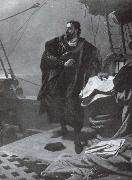 |
Karl Theodor von Piloty
|
|
German, 1826-1886,German painter. He received his first training from his father, the lithographer Ferdinand Piloty (1786-1844). In 1838 Piloty entered the Munich Akademie der Bildenden Kenste and from 1840 became a pupil of Julius Schnorr von Carolsfeld. Piloty had to manage the family business after his father's death in 1844, but in 1846 he returned to the Akademie as a pupil of Karl Schorn (1801-50). His artistic development was influenced by the work of the Antwerp artist Louis Gallait (1810-87), the heightened colour and multi-figure compositions in whose history paintings especially impressed him. Besides his study of Old Masters, especially Veronese and Rubens, he was influenced by French history painters like Paul Delaroche and Horace Vernet. His history painting Seni by the Body of Wallenstein (1855; Munich, Neue Pin.) was an enormous success, allowing him to take a leading role in the art life of Munich. In 1860 he was ennobled.
|
|
|
|
 |
Karl Kaspar Pitz
|
|
painted Portrait of a cleric a book in his right hand, by a marble bust in before 1795
|
|
 |
Karl Ernst Papf
|
|
Karl Ernest Papf (Dresden, Germany, 1833 -Sao Paulo, 1910) was a German painter, and draftsman that moved to Brazil in 1867.
He studied in the Academy of Fine Arts of Dresden and in 1867, was hired for the profession of photographer by the firm of his compatriot Albert Henschel. He initially worked in Recife until 1872, then in Salvador until 1877 - always in service of the atelier Albert Henschel & Cia., as written in Almanak Laemmert. He moved to Rio de Janeiro in surch for a better environment for the development of his work.
|
|
 |
Karel Purkyne
|
|
(1834-1868) was a Czech painter. He was one of the most prominent proponents of realism in Czech art in the second half of the 19th century. He was the son of the physiologist and anatomist Jan Evangelista Purkyne, and developed an interest in art while still young. Early influences included the Baroque painters Karel Škreta and Petr Brandl and the paintings of the Dutch Golden Age. He spent a year in Munich studying with Johann Baptist Berdelle before traveling to Paris, where he worked with Thomas Couture; there he copied paintings by Old Masters and encountered the work of contemporary French artists. He was particularly struck by the works of Gustave Courbet. Upon returning to Prague, Purkyne became known primarily as a portraitist, though a handful of works in other genres are known. He also made a name for himself as an organizer of artistic events and as an art critic.
|
|
 |
Kane Paul
|
|
Irish-born Canadian Painter
b.1810 d.1871
was an Irish-Canadian painter, famous for his paintings of First Nations peoples in the Canadian West and other Native Americans in the Oregon Country. A largely self-educated artist, Kane grew up in Toronto (then known as York) and trained himself by copying European masters on a study trip through Europe. He undertook two voyages through the wild Canadian northwest in 1845 and from 1846 to 1848. The first trip took him from Toronto to Sault Ste. Marie and back. Having secured the support of the Hudson's Bay Company, he set out on a second, much longer voyage from Toronto across the Rocky Mountains to Fort Vancouver and Fort Victoria in the Columbia District, as the Canadians called the Oregon Country. On both trips Kane sketched and painted Aboriginal peoples and documented their lives. Upon his return to Toronto, he produced more than one hundred oil paintings from these sketches. Kane's work, particularly his field sketches, are still a valuable resource for ethnologists.
|
|
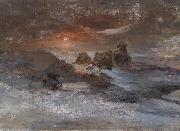 |
Julius Payer
|
|
Julius Johannes Ludovicus Ritter von Payer (2 September 1841 - 19 August 1915) was an Austro-Hungarian arctic explorer and an Arctic landscape artist.
Born Julius Payer, his father Franz Anton Rudolf Payer was a retired officer who died when Julius was only fourteen. Payer attended k.k. cadet school in Lobzowa near Krakew (now Poland). Between 1857 and 1859 he studied at the Theresian Military Academy in Wiener Neustadt (near Vienna). In 1859 he served as a sub-lieutenant with the 36th. infantry regiment in Verona, Northern Italy. He participated in the 1859 Battle of Solferino. Between 1860 and 1863 he served at the garrison in Verona, Italy. In 1863 Payer was assigned as a history teacher to the cadet school in Eisenstadt, Austria. After promotion to the rank of lieutenant first class he was posted to the garrison of Venetia.
In 1862 he started exploratory tours of the Italian Alps and Hohe Tauern in his free time. From 1864-1868 he explored the Adamello-Presanella Group and the Ortler Alps. He was the first to climb Adamello (3554m). His tours resulted in creating a detailed topographical map at a scale 1:56,000. Due to his achievements, Payer was transferred to the Austrian Military Cartographical Institute in Vienna.
|
|
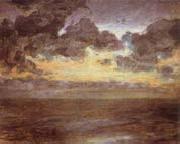 |
Julius Paulsen
|
|
Danish, 1860-1940
Danish painter. He studied at the Kongelige Akademi for de Skenne Kunster, Copenhagen (1879-82), but found the training there uninspired and soon attached himself to more radical artists such as Peder Severin Kreyer and Laurits Regner Tuxen. A turning-point in his career came in 1885 when, with Viggo Johansen, he went to Paris. On the way they visited Amsterdam, where the art of Rembrandt made a great impact on Paulsen; in Paris he showed interest in Courbet and Monet. From 1886 his time was shared between landscape, figure and portrait painting. His first landscape, From the Village of Ry (1886; Copenhagen, Hirschsprungske Saml.), is an early example of his personal blend of Romanticism and Symbolism; it shows a golden sunset colouring the houses and gardens of the small village. His View from the Harbour after Sunset (1891; Copenhagen, Hirschsprungske Saml.) has much in common with Monet, the Copenhagen skyline barely discernible through a deep blue and iridescent atmosphere. A later visit to Paris inspired such sunlit townscapes as Under Pont des Arts in Paris, Midday Sun (1919; Copenhagen, Stat. Mus. Kst), the shimmering, sketchy surface of which is dominated by fresh blues and greens; the painting incorporates a favourite Impressionist motif, the curved filigree of the iron bridge, which both frames the scene and lends it tension.
|
|
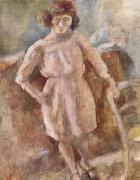 |
Jules Pascin
|
|
Bulgarian-born French Expressionist Painter, 1885-1930,American painter, draughtsman and printmaker of Bulgarian birth, active in France. He attended secondary school in Vienna, returning in 1901 to Bucharest, where his family had settled, and working briefly in the office of his father's grain-merchandizing business. He was, however, already becoming passionately interested in drawing, for which he showed precocious talent. At the age of 16 he became the lover of a woman who ran a brothel and was allowed by her to draw the residents. In 1903 he moved to Munich, where he attended the art school run by Moritz Heymann.
|
|
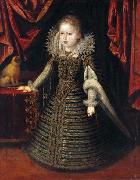 |
Juan Pantoja de la Cruz
|
|
(Valladolid, 1553 - 26 October 1608, Madrid) Spanish painter, one of the best representatives of the Spanish school of court painters. He worked for Philip II and Philip III. The Museo del Prado contains examples of his severe portraiture style.
Juan Pantoja de La Cruz was, born 1553 in Valladolid. Very little is known of his formative years as a painter. He was a pupil of the court painter Alonso Senchez Coello in Madrid and he must have assisted his master in complying with his duties as painter of the Spanish King, Philip II. Pantoja probably continued to work in his master studio after completing his training. He married in 1585 beginning to paint for the court around that time. After Sanchez Coello's death in 1588, Pantoja took over his master workshop and became court painter to Philip II of Spain.
Pantoja kept working for the court and the nobility, painting portraits of Prince Philip, the future Philip III, in 1592 and 1594. Among his most well known works is the portrait of Philip II wearing a cape and hat all in black, painted around 1594 for the Escorial. This portrait is one of the best representations of the idea of Spanish majesty, based on the remoteness of the monarch. On Philip II's death in 1598, Philip III confirmed Pantoja's status as court painter. When the court settled in Valladolid in 1601, Pantoja moved to the new capital, remaining in this city, several years.
|
|
|
|
|
|
|
|
|
|
|
| Wholesale China Oil Painting Wholesale Oil Painting China Xiamen Portrait Reproduction on canvas Chinese Oil Painting Wholesale USA Oil Painting |
|
|
|
|
|